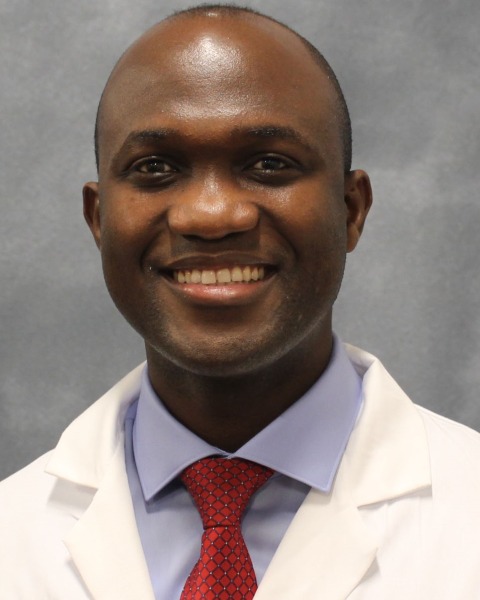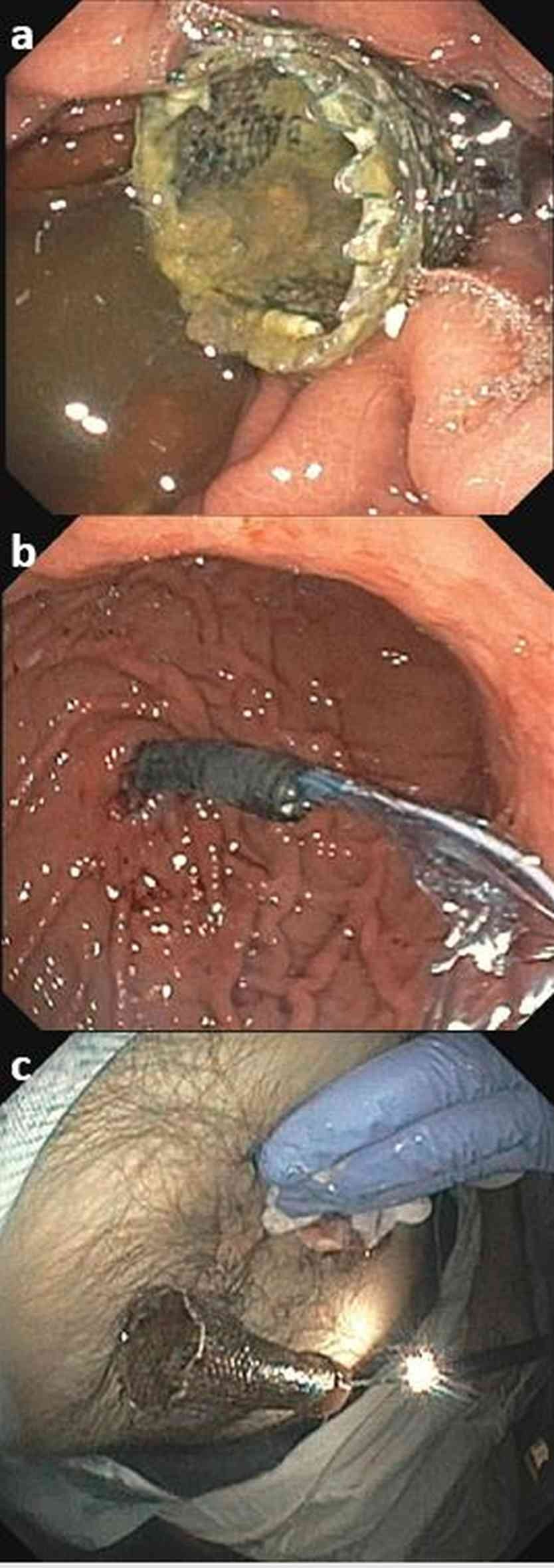Back


Poster Session B - Monday Morning
Category: Interventional Endoscopy
B0474 - Dislodged Esophageal Stent Extracted via PEG Tube Site: An Uncommon Solution for a Real Life Problem
Monday, October 24, 2022
10:00 AM – 12:00 PM ET
Location: Crown Ballroom

Has Audio

Kwabena O. Adu-Gyamfi, MBChB
Medical College of Georgia - Augusta University
Augusta, GA
Presenting Author(s)
Kwabena O. Adu-Gyamfi, MBChB1, Praneeth Kudaravalli, MD2, Viveksandeep Chandrasekar, MBBS3, Subbaramiah Sridhar, MBBS, MPH4, John Erikson L. Yap, MD3
1Medical College of Georgia - Augusta University, Augusta, GA; 2Augusta University Medical Center, Augusta, GA; 3Augusta University Medical College of Georiga, Augusta, GA; 4Medical College of Georgia, Augusta, GA
Introduction: Esophageal stents have been used for management of refractory benign strictures and has risk of stent migration even with endoscopic suturing or clipping techniques. With esophageal stricture present, the retrieval of the migrated stent becomes a dilemma. We present one such case that required retrieval of the migrated stent through a pre-existing percutaneous endoscopic gastrostomy (PEG) tube site.
Case Description/Methods: A 62-year-old man with history of supraglottic small cell carcinoma treated with chemo-radiation therapy developed a severe benign esophageal stricture. He had multiple esophageal dilations and steroid injections which failed and eventually treated by esophageal stent placement with stent fixation via endoscopic suturing. He presented with food impaction and esophagogastroduodenoscopy (EGD) found a severe distal esophageal stricture which could only be traversed with a pediatric gastroscope. The previously placed 20mmx80mm fully covered self-expanding metal stent (FCSEMS) had migrated into the stomach (Fig 1a). Exhaustive attempts at endoscopic retrieval past the esophageal stricture was unsuccessful. He had a pre-existing 20Fr PEG tube and the PEG tract was gradually dilated to 15mm. An adult gastroscope was passed through the PEG site and a raptor forceps was used to grab and extract the forceps successfully (Fig 1b-c). A new 24Fr PEG tube was placed. Mild oozing was seen in the tract, otherwise patient tolerated the procedure well. He was referred to discuss surgical options for further treatment of his esophageal stricture.
Discussion: Esophageal stents are being increasingly utilized in the management of not only malignant strictures, but also benign esophageal disease such as recurrent esophageal strictures, anastomotic leaks, perforations and fistulae. Stent migration may occur frequently in benign disease with risk factors being use of FCSEMS, distal location and previous migration. An unretrieved stent may cause small bowel obstruction. Anchoring stents with endoscopic suturing, and clips may reduce the risk of migration. If unable to be removed endoscopically then a surgical approach will be needed. Luckily, the presence of a mature gastrostomy tract provided an alternate extraction route for our patient. Risks associated with this modality include bleeding, gastrostomy site disruption, gastric perforation and peritonitis. Increased physician awareness of endoscopic options in such a case may obviate the need for surgical intervention.

Disclosures:
Kwabena O. Adu-Gyamfi, MBChB1, Praneeth Kudaravalli, MD2, Viveksandeep Chandrasekar, MBBS3, Subbaramiah Sridhar, MBBS, MPH4, John Erikson L. Yap, MD3. B0474 - Dislodged Esophageal Stent Extracted via PEG Tube Site: An Uncommon Solution for a Real Life Problem, ACG 2022 Annual Scientific Meeting Abstracts. Charlotte, NC: American College of Gastroenterology.
1Medical College of Georgia - Augusta University, Augusta, GA; 2Augusta University Medical Center, Augusta, GA; 3Augusta University Medical College of Georiga, Augusta, GA; 4Medical College of Georgia, Augusta, GA
Introduction: Esophageal stents have been used for management of refractory benign strictures and has risk of stent migration even with endoscopic suturing or clipping techniques. With esophageal stricture present, the retrieval of the migrated stent becomes a dilemma. We present one such case that required retrieval of the migrated stent through a pre-existing percutaneous endoscopic gastrostomy (PEG) tube site.
Case Description/Methods: A 62-year-old man with history of supraglottic small cell carcinoma treated with chemo-radiation therapy developed a severe benign esophageal stricture. He had multiple esophageal dilations and steroid injections which failed and eventually treated by esophageal stent placement with stent fixation via endoscopic suturing. He presented with food impaction and esophagogastroduodenoscopy (EGD) found a severe distal esophageal stricture which could only be traversed with a pediatric gastroscope. The previously placed 20mmx80mm fully covered self-expanding metal stent (FCSEMS) had migrated into the stomach (Fig 1a). Exhaustive attempts at endoscopic retrieval past the esophageal stricture was unsuccessful. He had a pre-existing 20Fr PEG tube and the PEG tract was gradually dilated to 15mm. An adult gastroscope was passed through the PEG site and a raptor forceps was used to grab and extract the forceps successfully (Fig 1b-c). A new 24Fr PEG tube was placed. Mild oozing was seen in the tract, otherwise patient tolerated the procedure well. He was referred to discuss surgical options for further treatment of his esophageal stricture.
Discussion: Esophageal stents are being increasingly utilized in the management of not only malignant strictures, but also benign esophageal disease such as recurrent esophageal strictures, anastomotic leaks, perforations and fistulae. Stent migration may occur frequently in benign disease with risk factors being use of FCSEMS, distal location and previous migration. An unretrieved stent may cause small bowel obstruction. Anchoring stents with endoscopic suturing, and clips may reduce the risk of migration. If unable to be removed endoscopically then a surgical approach will be needed. Luckily, the presence of a mature gastrostomy tract provided an alternate extraction route for our patient. Risks associated with this modality include bleeding, gastrostomy site disruption, gastric perforation and peritonitis. Increased physician awareness of endoscopic options in such a case may obviate the need for surgical intervention.

Figure: Fig 1. Endoscopic image of dislodged esophageal stent in stomach (Fig 1a). Endoscopic image of adult gastroscope passed through PEG site dilated with CRE balloon (Fig 1b). Image of dislodged esophageal stent retrieved via dilated PEG site (Fig 1c).
Disclosures:
Kwabena Adu-Gyamfi indicated no relevant financial relationships.
Praneeth Kudaravalli indicated no relevant financial relationships.
Viveksandeep Chandrasekar indicated no relevant financial relationships.
Subbaramiah Sridhar indicated no relevant financial relationships.
John Erikson Yap indicated no relevant financial relationships.
Kwabena O. Adu-Gyamfi, MBChB1, Praneeth Kudaravalli, MD2, Viveksandeep Chandrasekar, MBBS3, Subbaramiah Sridhar, MBBS, MPH4, John Erikson L. Yap, MD3. B0474 - Dislodged Esophageal Stent Extracted via PEG Tube Site: An Uncommon Solution for a Real Life Problem, ACG 2022 Annual Scientific Meeting Abstracts. Charlotte, NC: American College of Gastroenterology.
